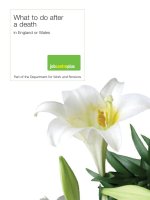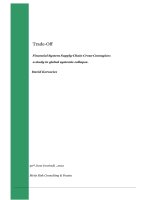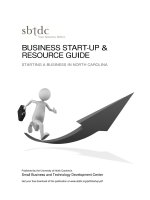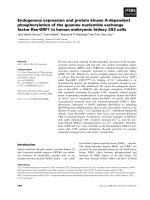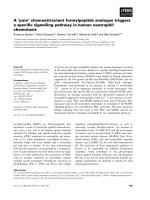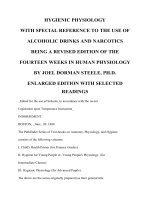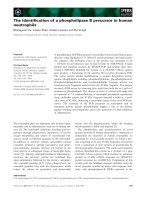Noise a flaw in human judgment
Bạn đang xem bản rút gọn của tài liệu. Xem và tải ngay bản đầy đủ của tài liệu tại đây (4.81 MB, 519 trang )
Copyright © 2021 by Daniel Kahneman, Olivier Sibony, and
Cass R. Sunstein
Cover design by Julian Humphries
Cover photograph copyright © Shutterstock
Cover copyright © 2021 by Hachette Book Group, Inc.
Hachette Book Group supports the right to free expression
and the value of copyright. The purpose of copyright is to
encourage writers and artists to produce the creative works
that enrich our culture.
The scanning, uploading, and distribution of this book
without permission is a theft of the author’s intellectual
property. If you would like permission to use material from
the book (other than for review purposes), please contact
Thank you for your support of
the author’s rights.
Little, Brown Spark
Hachette Book Group
1290 Avenue of the Americas, New York, NY 10104
littlebrownspark.com
twitter.com/lbsparkbooks
facebook.com/littlebrownspark
Instagram.com/littlebrownspark
First ebook edition: May 2021
Little, Brown Spark is an imprint of Little, Brown and
Company, a division of Hachette Book Group, Inc. The Little,
Brown Spark name and logo are trademarks of Hachette
Book Group, Inc.
The publisher is not responsible for websites (or their
content) that are not owned by the publisher.
ISBN 978-0-316-45138-3
E3-20210415-JV-NF-ORI
Contents
Cover
Title Page
Copyright
Dedication
Introduction: Two Kinds of Error
Part I: Finding Noise
1. Crime and Noisy Punishment
2. A Noisy System
3. Singular Decisions
Part II: Your Mind Is a Measuring Instrument
4. Matters of Judgment
5. Measuring Error
6. The Analysis of Noise
7. Occasion Noise
8. How Groups Amplify Noise
Part III: Noise in Predictive Judgments
9. Judgments and Models
10. Noiseless Rules
11. Objective Ignorance
12. The Valley of the Normal
Part IV: How Noise Happens
13. Heuristics, Biases, and Noise
14. The Matching Operation
15. Scales
16. Patterns
17. The Sources of Noise
Part V: Improving Judgments
18. Better Judges for Better Judgments
19. Debiasing and Decision Hygiene
20. Sequencing Information in Forensic Science
21. Selection and Aggregation in Forecasting
22. Guidelines in Medicine
23. Defining the Scale in Performance Ratings
24. Structure in Hiring
25. The Mediating Assessments Protocol
Part VI: Optimal Noise
26. The Costs of Noise Reduction
27. Dignity
28. Rules or Standards?
Review and Conclusion: Taking Noise Seriously
Epilogue: A Less Noisy World
Appendix A: How to Conduct a Noise Audit
Appendix B: A Checklist for a Decision Observer
Appendix C: Correcting Predictions
Acknowledgments
Notes
Discover More
About the Authors
Also by Daniel Kahneman
For Noga, Ori and Gili—DK
For Fantin and Lélia—OS
For Samantha—CRS
Explore book giveaways, sneak peeks, deals, and
more.
Tap here to learn more .
INTRODUCTION
Two Kinds of Error
I magine that four teams of friends have gone to a shooting
arcade. Each team consists of five people; they share one
rifle, and each person fires one shot. Figure 1 shows their
results.
In an ideal world, every shot would hit the bull’s-eye.
FIGURE 1: Four teams
That is nearly the case for Team A. The team’s shots are
tightly clustered around the bull’s-eye, close to a perfect
pattern.
We call Team B biased because its shots are
systematically off target. As the figure illustrates, the
consistency of the bias supports a prediction. If one of the
team’s members were to take another shot, we would bet
on its landing in the same area as the first five. The
consistency of the bias also invites a causal explanation:
perhaps the gunsight on the team’s rifle was bent.
We call Team C noisy because its shots are widely
scattered. There is no obvious bias, because the impacts are
roughly centered on the bull’s-eye. If one of the team’s
members took another shot, we would know very little
about where it is likely to hit. Furthermore, no interesting
hypothesis comes to mind to explain the results of Team C.
We know that its members are poor shots. We do not know
why they are so noisy.
Team D is both biased and noisy. Like Team B, its shots
are systematically off target; like Team C, its shots are
widely scattered.
But this is not a book about target shooting. Our topic is
human error. Bias and noise—systematic deviation and
random scatter—are different components of error. The
targets illustrate the difference.
The shooting range is a metaphor for what can go wrong
in human judgment, especially in the diverse decisions that
people make on behalf of organizations. In these situations,
we will find the two types of error illustrated in figure 1 .
Some judgments are biased; they are systematically off
target. Other judgments are noisy, as people who are
expected to agree end up at very different points around the
target. Many organizations, unfortunately, are afflicted by
both bias and noise.
Figure 2 illustrates an important difference between bias
and noise. It shows what you would see at the shooting
range if you were shown only the backs of the targets at
which the teams were shooting, without any indication of
the bull’s-eye they were aiming at.
From the back of the target, you cannot tell whether
Team A or Team B is closer to the bull’s-eye. But you can tell
at a glance that Teams C and D are noisy and that Teams A
and B are not. Indeed, you know just as much about scatter
as you did in figure 1 . A general property of noise is that
you can recognize and measure it while knowing nothing
about the target or bias.
FIGURE 2: Looking at the back of
the target
The general property of noise just mentioned is essential
for our purposes in this book, because many of our
conclusions are drawn from judgments whose true answer is
unknown or even unknowable. When physicians offer
different diagnoses for the same patient, we can study their
disagreement without knowing what ails the patient. When
film executives estimate the market for a movie, we can
study the variability of their answers without knowing how
much the film eventually made or even if it was produced at
all. We don’t need to know who is right to measure how
much the judgments of the same case vary. All we have to
do to measure noise is look at the back of the target.
To understand error in judgment, we must understand
both bias and noise. Sometimes, as we will see, noise is the
more important problem. But in public conversations about
human error and in organizations all over the world, noise is
rarely recognized. Bias is the star of the show. Noise is a bit
player, usually offstage. The topic of bias has been
discussed in thousands of scientific articles and dozens of
popular books, few of which even mention the issue of
noise. This book is our attempt to redress the balance.
In real-world decisions, the amount of noise is often
scandalously high. Here are a few examples of the alarming
amount of noise in situations in which accuracy matters: •
Medicine is noisy. Faced with the same patient, different
doctors make different judgments about whether patients
have skin cancer, breast cancer, heart disease, tuberculosis,
pneumonia, depression, and a host of other conditions.
Noise is especially high in psychiatry, where subjective
judgment is obviously important. However, considerable
noise is also found in areas where it might not be expected,
such as in the reading of X-rays.
• Child custody decisions are noisy. Case managers in
child protection agencies must assess whether children
are at risk of abuse and, if so, whether to place them in
foster care. The system is noisy, given that some
managers are much more likely than others to send a
child to foster care. Years later, more of the unlucky
children who have been assigned to foster care by these
heavy-handed managers have poor life outcomes: higher
delinquency rates, higher teen birth rates, and lower
earnings.
• Forecasts are noisy. Professional forecasters offer highly
variable predictions about likely sales of a new product,
likely growth in the unemployment rate, the likelihood of
bankruptcy for troubled companies, and just about
everything else. Not only do they disagree with each
other, but they also disagree with themselves. For
example, when the same software developers were
asked on two separate days to estimate the completion
time for the same task, the hours they projected differed
by 71%, on average.
• Asylum decisions are noisy. Whether an asylum seeker
will be admitted into the United States depends on
something like a lottery. A study of cases that were
randomly allotted to different judges found that one
judge admitted 5% of applicants, while another admitted
88%. The title of the study says it all: “Refugee
Roulette.” (We are going to see a lot of roulette.) •
Personnel decisions are noisy. Interviewers of job
candidates make widely different assessments of the
same people. Performance ratings of the same
employees are also highly variable and depend more on
the person doing the assessment than on the
performance being assessed.
• Bail decisions are noisy. Whether an accused person will
be granted bail or instead sent to jail pending trial
depends partly on the identity of the judge who ends up
hearing the case. Some judges are far more lenient than
others. Judges also differ markedly in their assessment
of which defendants present the highest risk of flight or
reoffending.
• Forensic science is noisy. We have been trained to think
of fingerprint identification as infallible. But fingerprint
examiners sometimes differ in deciding whether a print
found at a crime scene matches that of a suspect. Not
only do experts disagree, but the same experts
sometimes make inconsistent decisions when presented
with the same print on different occasions. Similar
variability has been documented in other forensic
science disciplines, even DNA analysis.
• Decisions to grant patents are noisy. The authors of a
leading study on patent applications emphasize the
noise involved: “Whether the patent office grants or
rejects a patent is significantly related to the
happenstance of which examiner is assigned the
application.” This variability is obviously troublesome
from the standpoint of equity.
All these noisy situations are the tip of a large iceberg.
Wherever you look at human judgments, you are likely to
find noise. To improve the quality of our judgments, we need
to overcome noise as well as bias.
This book comes in six parts. In part 1 , we explore the
difference between noise and bias, and we show that both
public and private organizations can be noisy, sometimes
shockingly so. To appreciate the problem, we begin with
judgments in two areas. The first involves criminal
sentencing (and hence the public sector). The second
involves insurance (and hence the private sector). At first
glance, the two areas could not be more different. But with
respect to noise, they have much in common. To establish
that point, we introduce the idea of a noise audit, designed
to measure how much disagreement there is among
professionals considering the same cases within an
organization.
In part 2 , we investigate the nature of human judgment
and explore how to measure accuracy and error. Judgments
are susceptible to both bias and noise. We describe a
striking equivalence in the roles of the two types of error.
Occasion noise is the variability in judgments of the same
case by the same person or group on different occasions. A
surprising amount of occasion noise arises in group
discussion because of seemingly irrelevant factors, such as
who speaks first.
Part 3 takes a deeper look at one type of judgment that
has been researched extensively: predictive judgment. We
explore the key advantage of rules, formulas, and
algorithms over humans when it comes to making
predictions: contrary to popular belief, it is not so much the
superior insight of rules but their noiselessness. We discuss
the ultimate limit on the quality of predictive judgment—
objective ignorance of the future—and how it conspires with
noise to limit the quality of prediction. Finally, we address a
question that you will almost certainly have asked yourself
by then: if noise is so ubiquitous, then why had you not
noticed it before?
Part 4 turns to human psychology. We explain the central
causes of noise. These include interpersonal differences
arising from a variety of factors, including personality and
cognitive style; idiosyncratic variations in the weighting of
different considerations; and the different uses that people
make of the very same scales. We explore why people are
oblivious to noise and are frequently unsurprised by events
and judgments they could not possibly have predicted.
Part 5 explores the practical question of how you can
improve your judgments and prevent error. (Readers who
are primarily interested in practical applications of noise
reduction might skip the discussion of the challenges of
prediction and of the psychology of judgment in parts 3 and
4 and move directly to this part.) We investigate efforts to
tackle noise in medicine, business, education, government,
and elsewhere. We introduce several noise-reduction
techniques that we collect under the label of decision
hygiene. We present five case studies of domains in which
there is much documented noise and in which people have
made sustained efforts to reduce it, with instructively
varying degrees of success. The case studies include
unreliable medical diagnoses, performance ratings, forensic
science, hiring decisions, and forecasting in general. We
conclude by offering a system we call the mediating
assessments protocol: a general-purpose approach to the
evaluation of options that incorporates several key practices
of decision hygiene and aims to produce less noisy and
more reliable judgments.
What is the right level of noise? Part 6 turns to this
question. Perhaps counterintuitively, the right level is not
zero. In some areas, it just isn’t feasible to eliminate noise.
In other areas, it is too expensive to do so. In still other
areas, efforts to reduce noise would compromise important
competing values. For example, efforts to eliminate noise
could undermine morale and give people a sense that they
are being treated like cogs in a machine. When algorithms
are part of the answer, they raise an assortment of
objections; we address some of them here. Still, the current
level of noise is unacceptable. We urge both private and
public organizations to conduct noise audits and to
undertake, with unprecedented seriousness, stronger efforts
to reduce noise. Should they do so, organizations could
reduce widespread unfairness—and reduce costs in many
areas.
With that aspiration in mind, we end each chapter with a
few brief propositions in the form of quotations. You can use
these statements as they are or adapt them for any issues
that matter to you, whether they involve health, safety,
education,
money,
employment,
entertainment,
or
something else. Understanding the problem of noise, and
trying to solve it, is a work in progress and a collective
endeavor. All of us have opportunities to contribute to this
work. This book is written in the hope that we can seize
those opportunities.
PART I
Finding Noise
I
t is not acceptable for similar people, convicted of the
same offense, to end up with dramatically different
sentences—say, five years in jail for one and probation for
another. And yet in many places, something like that
happens. To be sure, the criminal justice system is pervaded
by bias as well. But our focus in chapter 1 is on noise—and
in particular, on what happened when a famous judge drew
attention to it, found it scandalous, and launched a crusade
that in a sense changed the world (but not enough). Our
tale involves the United States, but we are confident that
similar stories can be (and will be) told about many other
nations. In some of those nations, the problem of noise is
likely to be even worse than it is in the United States. We
use the example of sentencing in part to show that noise
can produce great unfairness.
Criminal sentencing has especially high drama, but we
are also concerned with the private sector, where the stakes
can be large, too. To illustrate the point, we turn in chapter 2
to a large insurance company. There, underwriters have the
task of setting insurance premiums for potential clients, and
claims adjusters must judge the value of claims. You might
predict that these tasks would be simple and mechanical
and that different professionals would come up with roughly
the same amounts. We conducted a carefully designed
experiment—a noise audit—to test that prediction. The
results surprised us, but more importantly they astonished
and dismayed the company’s leadership. As we learned, the
sheer volume of noise is costing the company a great deal
of money. We use this example to show that noise can
produce large economic losses.
Both of these examples involve studies of a large
number of people making a large number of judgments. But
many important judgments are singular rather than
repeated: how to handle an apparently unique business
opportunity, whether to launch a whole new product, how to
deal with a pandemic, whether to hire someone who just
doesn’t meet the standard profile. Can noise be found in
decisions about unique situations like these? It is tempting
to think that it is absent there. After all, noise is unwanted
variability, and how can you have variability with singular
decisions? In chapter 3 , we try to answer this question. The
judgment that you make, even in a seemingly unique
situation, is one in a cloud of possibilities. You will find a lot
of noise there as well.
The theme that emerges from these three chapters can
be summarized in one sentence, which will be a key theme
of this book: wherever there is judgment, there is noise—
and more of it than you think. Let’s start to find out how
much.
CHAPTER 1
Crime and Noisy Punishment
S uppose that someone has been convicted of a crime—
shoplifting, possession of heroin, assault, or armed robbery.
What is the sentence likely to be?
The answer should not depend on the particular judge to
whom the case happens to be assigned, on whether it is hot
or cold outside, or on whether a local sports team won the
day before. It would be outrageous if three similar people,
convicted of the same crime, received radically different
penalties: probation for one, two years in jail for another,
and ten years in jail for another. And yet that outrage can be
found in many nations—not only in the distant past but also
today.
All over the world, judges have long had a great deal of
discretion in deciding on appropriate sentences. In many
nations, experts have celebrated this discretion and have
seen it as both just and humane. They have insisted that
criminal sentences should be based on a host of factors
involving not only the crime but also the defendant’s
character and circumstances. Individualized tailoring was
the order of the day. If judges were constrained by rules,
criminals would be treated in a dehumanized way; they
would not be seen as unique individuals entitled to draw
attention to the details of their situation. The very idea of
due process of law seemed, to many, to call for open-ended
judicial discretion.
In the 1970s, the universal enthusiasm for judicial
discretion started to collapse for one simple reason:
startling evidence of noise. In 1973, a famous judge, Marvin
Frankel, drew public attention to the problem. Before he
became a judge, Frankel was a defender of freedom of
speech and a passionate human rights advocate who helped
found the Lawyers’ Committee for Human Rights (an
organization now known as Human Rights First).
Frankel could be fierce. And with respect to noise in the
criminal justice system, he was outraged. Here is how he
describes his motivation: If a federal bank robbery
defendant was convicted, he or she could receive a
maximum of 25 years. That meant anything from 0 to 25
years. And where the number was set, I soon realized,
depended less on the case or the individual defendant than
on the individual judge, i.e., on the views, predilections, and
biases of the judge. So the same defendant in the same
case could get widely different sentences depending on
which judge got the case.
Frankel did not provide any kind of statistical analysis to
support his argument. But he did offer a series of powerful
anecdotes, showing unjustified disparities in the treatment
of similar people. Two men, neither of whom had a criminal
record, were convicted for cashing counterfeit checks in the
amounts of $58.40 and $35.20, respectively. The first man
was sentenced to fifteen years, the second to 30 days. For
embezzlement actions that were similar to one another, one
man was sentenced to 117 days in prison, while another
was sentenced to 20 years . Pointing to numerous cases of
this kind, Frankel deplored what he called the “almost
wholly unchecked and sweeping powers” of federal judges,
resulting in “arbitrary cruelties perpetrated daily,” which he
deemed unacceptable in a “government of laws, not of
men.”
Frankel called on Congress to end this “discrimination,”
as he described those arbitrary cruelties. By that term, he
mainly meant noise, in the form of inexplicable variations in
sentencing. But he was also concerned about bias, in the
form of racial and socioeconomic disparities. To combat both
noise and bias, he urged that differences in treatment of
criminal defendants should not be allowed unless the
differences could be “justified by relevant tests capable of
formulation and application with sufficient objectivity to
ensure that the results will be more than the idiosyncratic
ukases of particular officials, justices, or others.” (The term
idiosyncratic ukases is a bit esoteric; by it, Frankel meant
personal edicts.) Much more than that, Frankel argued for a
reduction in noise through a “detailed profile or checklist of
factors that would include, wherever possible, some form of
numerical or other objective grading.”
Writing in the early 1970s, he did not go quite so far as
to defend what he called “displacement of people by
machines.” But startlingly, he came close. He believed that
“the rule of law calls for a body of impersonal rules,
applicable across the board, binding on judges as well as
everyone else.” He explicitly argued for the use of
“computers as an aid toward orderly thought in sentencing.”
He also recommended the creation of a commission on
sentencing.
Frankel’s book became one of the most influential in the
entire history of criminal law—not only in the United States
but also throughout the world. His work did suffer from a
degree of informality. It was devastating but impressionistic.
To test for the reality of noise, several people immediately
followed up by exploring the level of noise in criminal
sentencing.
An early large-scale study of this kind, chaired by Judge
Frankel himself, took place in 1974. Fifty judges from various
districts were asked to set sentences for defendants in
hypothetical cases summarized in identical pre-sentence
reports. The basic finding was that “absence of consensus
was the norm” and that the variations across punishments
were “astounding.” A heroin dealer could be incarcerated
for one to ten years, depending on the judge. Punishments
for a bank robber ranged from five to eighteen years in
prison. The study found that in an extortion case, sentences
varied from a whopping twenty years imprisonment and a
$65,000 fine to a mere three years imprisonment and no
fine. Most startling of all, in sixteen of twenty cases, there
was no unanimity on whether any incarceration was
appropriate.
This study was followed by a series of others, all of which
found similarly shocking levels of noise. In 1977, for
example, William Austin and Thomas Williams conducted a
survey of forty-seven judges, asking them to respond to the
same five cases, each involving low-level offenses. All the
descriptions of the cases included summaries of the
information used by judges in actual sentencing, such as the
charge, the testimony, the previous criminal record (if any),
social background, and evidence relating to character. The
key finding was “substantial disparity.” In a case involving
burglary, for example, the recommended sentences ranged
from five years in prison to a mere thirty days (alongside a
fine of $100). In a case involving possession of marijuana,
some
judges
recommended
prison
terms;
others
recommended probation.
A much larger study, conducted in 1981, involved 208
federal judges who were exposed to the same sixteen
hypothetical cases. Its central findings were stunning: In
only 3 of the 16 cases was there a unanimous agreement to
impose a prison term. Even where most judges agreed that
a prison term was appropriate, there was a substantial
variation in the lengths of prison terms recommended. In
one fraud case in which the mean prison term was 8.5
years, the longest term was life in prison. In another case
the mean prison term was 1.1 years, yet the longest prison
term recommended was 15 years.
As revealing as they are, these studies, which involve
tightly controlled experiments, almost certainly understate
the magnitude of noise in the real world of criminal justice.
Real-life judges are exposed to far more information than
what the study participants received in the carefully
specified vignettes of these experiments. Some of this
additional information is relevant, of course, but there is
also ample evidence that irrelevant information, in the form
of small and seemingly random factors, can produce major
differences in outcomes. For example, judges have been
found more likely to grant parole at the beginning of the day
or after a food break than immediately before such a break.
If judges are hungry, they are tougher.
A study of thousands of juvenile court decisions found
that when the local football team loses a game on the
weekend, the judges make harsher decisions on the Monday
(and, to a lesser extent, for the rest of the week). Black
defendants disproportionately bear the brunt of that
increased harshness. A different study looked at 1.5 million
judicial decisions over three decades and similarly found
that judges are more severe on days that follow a loss by
the local city’s football team than they are on days that
follow a win.
A study of six million decisions made by judges in France
over twelve years found that defendants are given more
leniency on their birthday. (The defendant’s birthday, that
is; we suspect that judges might be more lenient on their
own birthdays as well, but as far as we know, that
hypothesis has not been tested.) Even something as
irrelevant as outside temperature can influence judges. A
review of 207,000 immigration court decisions over four
years found a significant effect of daily temperature
variations: when it is hot outside, people are less likely to
get asylum. If you are suffering political persecution in your
home country and want asylum elsewhere, you should hope
and maybe even pray that your hearing falls on a cool day.
